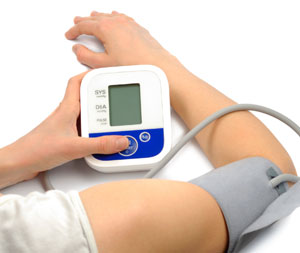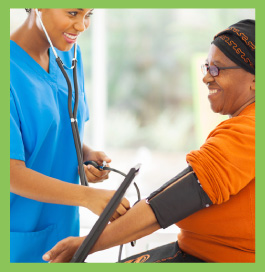Taking Action to Manage Your Blood Pressure
Diagnosis
Blood pressure is diagnosed by a doctor using a blood pressure machine. The process includes:
- Being seated in a chair with your back supported
- Putting your feet flat on the floor and supporting your arm at heart level
- Remaining quiet for five minutes and refraining from talking
It is very important to use the proper size cuff when taking a blood pressure reading. Failure to do so will lead to inaccuracies. A cuff that is too small for the arm circumference will give an artificially high reading. A cuff that is too large will give too low a reading. Initially, blood pressure should be measured in each arm to make sure both readings are the same. The arm with the higher readings should then be targeted for all future blood pressure checks.
If your blood pressure readings are high, your doctor may ask that you return for additional measurements on different days because blood pressure can vary widely from day to day.
Your doctor will most likely diagnose you with high blood pressure if you have several readings of 140/90 or higher.
If you have readings of 130/80 or higher and are diabetic or have chronic kidney disease, you are likely to be diagnosed with high blood pressure.
What This Means
High blood pressure can be lowered with lifestyle changes and medications. Only a properly trained health care professional can determine the appropriate methods for any particular case.
Medication Therapy For High Blood Pressure
If your blood pressure readings are high but within the range of 140-159/90-99, your doctor may tell you that lifestyle changes are sufficient treatment.
But sometimes lifestyle changes are not enough. This is the case when blood pressure levels do not diminish after several months of lifestyle changes, or when very high blood pressure poses an immediate threat to health. A person may need to take medication in addition to maintaining a healthy lifestyle, particularly those with:
- Organ damage
- Chronic kidney disease
- Diabetes
Most people who are on blood pressure medication require at least two different drugs in addition to lifestyle changes to properly treat their condition.
Many treatment options are available for lowering high blood pressure. See the table below for a better understanding of your options.
| Type of Medication | How They Work | Why They Are Prescribed | Side Effects |
|---|---|---|---|
|
ACE Inhibitors (angiotensin-converting enzyme) |
|
|
Call your doctor immediately if you experience:
|
| ARBs (Angiotensin- receptor blockers) |
|
|
Call your doctor immediately if you experience:
|
| Beta blockers |
|
|
Call your doctor immediately if you experience:
|
| Diuretics (or “water pill”) |
|
|
Call your doctor immediately if you experience:
|
| Calcium channel blockers |
|
|
Call your doctor immediately if you experience:
|
It is important to consider that different medications may work better for different people.
Blood pressure medications rarely change how you feel and have little or no side effects; however, side effects may still occur and could be serious.
If you think you are experiencing any type of abnormal reaction to your medication, it is important to consult your doctor immediately.
It is also very important to be patient when beginning blood pressure medications as it may take up to six weeks before any changes occur.
Best Practice Guidelines
More detailed information about the diagnosis and treatment of high blood pressure is available from Hypertension Canada.
Prevention And Management Strategies
Lifestyle changes can help you prevent and control high blood pressure. Here’s what you can do:
Eat a Balanced Diet
The Dietary Approaches to Stop Hypertension (DASH) diet, which emphasizes fruits, vegetables, whole grains, and low-fat dairy foods can help you reduce your systolic blood  pressure by 8-14 mm Hg. (For an overview of the DASH diet, see the table below.)
pressure by 8-14 mm Hg. (For an overview of the DASH diet, see the table below.)
Get plenty of potassium, which can help prevent and control high blood pressure.
To prevent and treat high blood pressure, a dietary sodium intake of 1,500 mg is recommended for adults younger than 50 years of age, 1,300 mg for those 51 to 69, and 1,200 mg for those older than 70. Individuals with high blood pressure whose sodium intake is 3,000 to 3,500 mg can reduce systolic blood pressure by 5.1 mm Hg if they cut out 1,800 mg of sodium.
Pay attention to the amount of salt that's in the processed foods you eat, such as canned soups or frozen dinners.
Achieve and Maintain a Healthy Weight
If you're overweight, a modest reduction in weight of 10% of your current body weight can lower your blood pressure. For every kilogram of weight loss, you can reduce your blood pressure by 1.1/0.9 mm Hg.
Increase Physical Activity
Regular physical activity can help lower your blood pressure and keep your weight under control. Aiming for 30 to 60 minutes of physical activity four to seven days a week can decrease total blood pressure by 4.9/3.7 mm Hg.
Limit Your Alcohol Intake
Even if you're healthy, alcohol can raise your blood pressure. If you choose to drink alcohol, do so in moderation — one to two drinks per day for a weekly maximum of nine for women and 14 for men. Limiting your alcohol could decrease your systolic blood pressure by 2-4 mm Hg.
Be Smoke-Free
Smoking leads to injured blood vessel walls and speeds up the process of hardening of the arteries. If you smoke and want to quit, visit our section about Smoking.
Manage Stress
Set aside some time every day to relax. Practice healthy coping techniques, such as muscle relaxation and deep breathing. Getting plenty of sleep can help, too.
Monitor Your Blood Pressure
Have your blood pressure checked regularly. High blood pressure often has no symptoms, so have yours checked by a health care professional at least once every two years or as often as your doctor suggests.
If you have been told you have high-normal blood pressure, or pre-hypertension, Canadian guidelines recommend that you have your blood pressure checked at least once a year.
If your blood pressure is under control, you may be able to make fewer visits to your doctor if you monitor your blood pressure at home. If your doctor has prescribed medication, take it as directed.
| Recommendation | ||
|---|---|---|
| Follow the DASH diet. | ||
| What Is the DASH Diet? | ||
|
||
| Healthy Food Guide with DASH | ||
| The DASH eating plan below is based on 2,000 calories per day. Different people need different amounts of food. The number of daily servings in each food group may vary from those listed depending on need. | ||
| Food Group | Daily Servings | Examples of Servings |
| Grains | 6-8 | 1 slice bread 1 small whole grain roll or 1 small low fat muffin ½ pita or ½ small bagel 30 g (1 oz) dry cereal* 175 ml (¾ cup) cooked cereal 125 ml (½ cup) cooked rice or pasta 3 cups air-popped popcorn 30 g serving of low-sodium low-fat crackers* |
| Vegetables | 4-5 | 1 cup raw leafy vegetables ½ cup cut-up cooked or raw vegetables ½ cup sodium reduced vegetable juice |
| Fruits | 4-5 | 1 medium fruit 125 ml (½ cup) fresh, frozen, or canned fruit 60 ml (¼ cup) dried fruit 125 ml (½ cup) fruit juice |
| Fat-free or low-fat milk and milk products | 2-3 | 250 ml (1 cup) skim or 1% milk 175 g (¾ cup) low-fat yogourt 50 g (1½ oz) low-fat cheese |
| Lean meats, poultry, and fish | 2 or less | 90 g (3 oz) roasted or broiled lean meats, skinless poultry, fish, or seafood 2 eggs (2-3 eggs per week) |
| Nuts, seeds, and legumes | 4-5 per week | 45 g (⅓ cup) nuts 15 g (2 tbsp) seeds 30 ml (2 tbsp) peanut butter 125 ml (½ cup) cooked legumes (dried beans, lentils, split peas, or chickpeas) 150 g (¾ cup) tofu |
| Fats and oils | 2-3 | 5 ml (1 tsp) vegetable oil 5 ml (1 tsp) soft margarine 5 ml (1 tsp) regular mayonnaise 15 ml (1 tbsp) low-fat mayonnaise 10 ml (2 tsp) regular salad dressing 30 ml (2 tbsp) low-fat salad dressing |
| Sweets and added sugars | 5 per week | 15 ml (1 tbsp) sugar, jelly, jam, or syrup 125 ml (½ cup) frozen yogourt or sherbet 125 ml (½ cup) Jell-O gelatin 15 jelly beans or 3 pieces of hard candy 1 serving of low-fat cookies* 250 ml (1 cup) regular lemonade, iced tea, or soda pop |
| * Serving sizes vary from brand to brand. Check the product's nutrition label. | ||
| The Link Between the DASH Diet and Heart Disease | ||
|
Blood pressure While either the DASH diet or the low-sodium diet lowers blood pressure, the combination of the DASH Diet and low-sodium diet gives the biggest benefit. |
||
About Lifestyle Changes
Doctors often first try to lower a patient’s blood pressure by having the patient make lifestyle changes, but like most change, it can be hard. If you had to focus on just three, the most important ones would be:
- Physical Activity: Get 30 to 60 minutes of exercise a day for as many as four to seven days a week
- Diet: Follow the DASH diet and aim for less than 2,300 mg sodium each day
- Quit Smoking: Find a program to help you quit
Find Out Whether You Have High Blood Pressure
This detailed video provides correct guidelines for measuring your blood pressure at home (Hypertension Canada).
View a printable form for home measuring instructions.
How To Measure Your Own Blood Pressure
If you are taking your blood pressure at home, here are some important things to consider to get the most accurate results.
You may experience higher numbers when you are taking your blood pressure at the doctor’s office. This could be from the anxious feeling people sometimes get when a health care professional or someone in a white coat is present. This is known as white coat syndrome.
Home blood pressure monitoring is a good idea because it can help avoid the possibility masking your true blood pressure values. You can find home blood pressure monitors in drugstores, pharmacies, grocery stores, and department stores.


